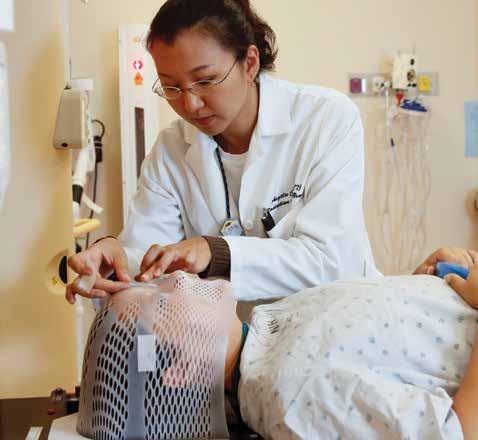
5 minute read
On The Horizon
Alternatives to Chemotherapy
Newer cancer treatments attempt to minimize negative side effects
Cancer has long been a leading cause of death in the United States. The CDC regularly reports more than half a million cancer related deaths each year. In the rapidly changing world of modern medicine, researchers aren’t just working to find new treatments, but ones that are less physically difficult too.
Since the discovery in the 1940s that chemicals could be used to treat cancers, chemotherapy has been one of the most commonly used cancer treatments. Chemotherapy targets cells that grow and divide at uncontrollable speeds.
Though chemotherapy can halt cancer cells from dividing, it doesn’t come without side effects. According to Medical News Today, because chemotherapy doesn’t target specific cells or regions within the body, it can affect an individual’s entire body, including fast-growing healthy cells found in skin, hair, intestines and bone marrow. The chemotherapy, not the cancer itself, is the cause for so many side effects that we often relate with cancer, including hair loss.
Medicine is ever-changing, and researchers have sought to combat these side effects through a number of alternatives to chemotherapy.
Systemic Therapies
Systemic therapies use drugs that spread throughout the body to treat cancer cells wherever they may be. Some prominent examples include immunotherapy and targeted drugs.
While chemotherapy, a type of systemic therapy, directly targets cancerous cells, immunotherapy works by boosting an individual’s immune system response. Immunotherapy can teach the immune system how to identify and effectively destroy cancer cells.
Administered through an IV infusion, immunotherapy gives individuals with late-stage cancers a new treatment option. The therapy uses the continual adaptions of the immune system in the hopes that, if a tumor escapes detection, the immune system can adjust itself to launch further targeted attacks.
Immunotherapy still comes with its own side effects. These can include fever, chills, weakness and nausea. Immunotherapy, unlike localized therapies, isn’t meant to target one part of the body; it is effective in treating cancers throughout an individual’s entire body, according to the Cancer Research Institute.
Targeted drugs offer another treatment route focusing on individual proteins. In targeted drug therapy, doctors take a tumor or blood sample to identify an individual’s genetic profile. This allows the doctor to administer medication that directly targets cancer-causing genes, according to Rush University Medical Center. These medicines can enter cells and antibodies easily and attach to specific targets on cancer cells.
Targeted therapy is precise and gives doctors the ability to attack cancer cells while ignoring a person’s healthy cells. Still, this treatment isn’t without its own side effects. Targeted therapy may cause diarrhea or liver problems, and genetic testing raises concerns regarding privacy too.
The fact that systemic therapies affect the entire body can make them a challenging option for some patients.
“Systemic therapies can be hard to tolerate,” says Dr. Mary E. Dillhoff, a surgical oncologist at The Ohio State University Comprehensive Cancer Center. “Maybe you’re not well enough to have some of those therapies that can be hard on your body.”
A patient receiving a computed tomography scan to identify the precise region to administer radiation therapy.
Local Therapies

Local therapies circumvent some of the difficulties of systemic therapies by targeting a specific organ or area of the body. These treatments include surgery and radiation.
“With local therapies, you’re only getting that effect for the area you’re working on,” Dillhoff says.
Surgery, where a surgical oncologist removes all or most of a solid tumor, is an option for most cancers other than blood cancers. Surgery can be especially effective in removing an early-stage tumor that hasn’t spread to other parts of the body. A small procedure could remove an individual’s tumor and circumvents many side effects.
An effective method for killing cancer cells in a localized area of the body is radiation therapy. Radiation therapy kills cancer cells with high-energy beams such as X-rays or protons. Because of this, the side effects of radiation can be localized as well, and individuals might notice particular pain or difficulties in the area the radiation was administered.
Surgery and radiation are often used in conjunction with one another. For example, radiation can be used to shrink a tumor before removing it with surgery or to kill any remaining cancer cells after surgery. Many times chemotherapy is used alongside these methods as well. But, because of chemotherapy’s side effects, it’s not suitable for every patient.
“Sometimes a patient is just too frail (for chemotherapy),” Dillhoff says. “Their health is poor enough that you’ll cause more harm with (chemotherapy) than what you’ll benefit. In those times, we need to be very thoughtful about what we’re going to gain for that individual person by giving them those drugs.”
Most cancer treatments use multiple treatments in collaboration though, all striving for the same goal: a cure.
“Most effective treatments are a combination of these things,” Dillhoff says. “You need an expert that can help guide you through this combination of what comes first and what comes next.”

Megan Roth is an editorial assistant. Feedback welcome at feedback@ cityscenemediagroup.com.
The assistance you need, when you need it


New Albany Rehabilitation, Skilled Nursing & Assisted Living Center offers well-appointed senior apartments, housekeeping, meals and personal care and support services as needed.
• Private apartments and suites • Beautiful courtyards with walking paths • Well-appointed dining room, restaurantstyle meals, room service and snacks • Transportation • 24-hour professional nursing staff • Health and wellness monitoring • Medication management • Assistance with bathing, dressing and grooming • Physical, occupational and speech therapy available • Podiatry, dental, optometry and psychological services For more information on our services call
614.855.8866
5691 Thompson Road Columbus, OH 43230 or visit our Website: www.macintoshcompany.com/new-albany
New Albany Rehabilitation, Skilled Nursing & Assisted Living Center A Macintosh Community
Personalized. Uncompromised. Healthcare.
Thinking of Selling Your New Albany Home?
For the Results You Want
614-939-8932
NewAlbanyOhio.com











